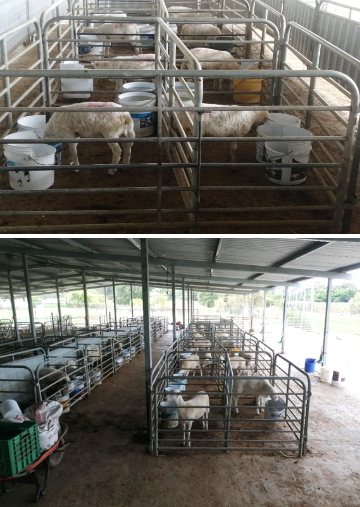PALATABILIDAD DE CUATRO CEREALES UTILIZADOS PARA ALIMENTAR CORDEROS
Palabras clave:
Maíz, cebada, sorgo, taninos, ingesta voluntariaResumen
La palatabilidad de los alimentos es variable y es afectada por diferentes factores. Por tanto, el objetivo fue evaluar la palatabilidad del grano de maíz amarillo, cebada, sorgo rojo y sorgo marrón en corderos. En ocho corderos se realizaron pruebas de palatabilidad de dos y cuatro opciones. Se midió la ingesta y preferencia del grano. Se utilizó un modelo lineal mixto donde el factor fijo fue: tipo de grano, día y su interacción; el factor aleatorio fue el cordero. Se demostró que el consumo y preferencia del maíz amarillo, cebada y sorgo es similar en la prueba de dos opciones, excepto por la preferencia del sorgo marrón que fue mayor que la cebada. En las cuatro opciones el consumo y preferencia fue menor en el sorgo marrón. Las diferencias en consumo de los cereales podrían estar relacionadas a la digestibilidad de los cereales y su combinación.
Citas
Cervantes-Pahm, S. K., Liu, Y., & Stein, H. H. (2013). Comparative digestibility of energy and nutrients and fermentability of dietary fiber in eight cereal grains fed to pigs. Journal of the Science of Food and Agriculture, 94(5), 841-849. https://doi.org/10.1002/jsfa.6316
Forbes, J. M., & Provenza, F. D. (2000). Integration of learning and metabolic signals into a theory of dietary choice and food intake. En Conjé, P. B. (Ed.), Ruminant physiology: Digestion, metabolism, growth and reproduction (pp. 3-19). CAB International.
Frutos, P., Hervás, G., Giráldez, F. J., & Mantecón, A. R. (2004). Review. Tannins and ruminant nutrition. Spanish Journal of Agricultural Research, 2(2), 191-202. https://doi. org/10.5424/sjar/2004022-73
Horadagoda, A., Fulkerson, W. J., Barchia, I., Dobos, R. C., & Nandra, K. S. (2008). The effect of grain species, processing and time of feeding on the efficiency of feed utilization and microbial protein synthesis in sheep. Livestock Science, 114(1), 117-126. https://doi. org/10.1016/j.livsci.2007.04.016
Lawson, R. E., Redfern, E. J., & Forbes, J. M. (2000). Choices by lactating cows between concentrates high or low in digestible undegraded protein. Animal Science, 70(3), 515-525. https://doi.org/10.1017/s1357729800051869
Nikkhah, A. (2012). Barley grain for ruminants: A global treasure or tragedy. Journal of Animal Science and Biotechnology, 3, 22. https://doi.org/10.1186/2049-1891-3-22
Patra, A. K., & Saxena, J. (2009). Dietary phytochemicals as rumen modifiers: a review of the effects on microbial populations. Antonie Van Leeuwenhoek, 96(4), 363-375. https://doi.org/10.1007/s10482-009-9364-1
Provenza, F. D. (1995). Postingestive feedback as an elementary determinant of food preference and intake in ruminants. Journal of Range Management, 48(1), 2-17.
Villalba, J. J., & Provenza, F. D. (1997). Preference for flavored wheat straw by lambs conditioned with intraruminal infusions of acetate and propionate. Journal of Animal Science, 75(11), 2905-2914. https://doi. org/10.2527/1997.75112905x
Villalba, J. J., & Provenza, F. D. (2000). Postingestive feedback from starch influences the ingestive behaviour of sheep consuming wheat straw. Applied Animal Behaviour Science, 66(1-2), 49-63. https://doi.org/10.1016/ s0168-1591(99)00081-7
Villalba, J. J., Provenza, F. D., & Bryant, J. P. (2002). Consequences of the interaction between nutrients and plant secondary metabolites on herbivore selectivity: benefits or detriments for plants? Oikos, 97(2), 282-292. https://doi.org/10.1034/j.1600-0706.2002.970214.x
Xiong, Y., Zhang, P., Warner, R. D., & Fang, Z. (2019). Sorghum grain: from genotype, nutrition, and phenolic profile to its health benefits and food applications. Comprehensive Reviews in Food Science and Food Safety, 18(6), 2025-2046. https://doi.org/10.1111/1541-4337.12506
Yahaghi, M., Liang, J. B., Balcells, J., Valizadeh, R., Seradj, A. R., Alimon, R., & Ho, Y. W. (2013). Effect of substituting barley with sorghum on starch digestion, rumen microbial yield and growth in Iranian Baluchi lambs fed high concentrate diets. Animal Feed Science and Technology, 183(3-4), 96-105. https://doi.org/10.1016/j. anifeedsci.2013.04.019
Yearsley, J. M., Villalba, J. J., Gordon, I. J., Kyriazakis, I., Speakman, J. R., Tolkamp, B. J., Illius A.W., & Duncan, A. J. (2006). A theory of associating food types with their postingestive consequences. The American Naturalist, 167: 705-716. https://doi.org/10.1086/502805






